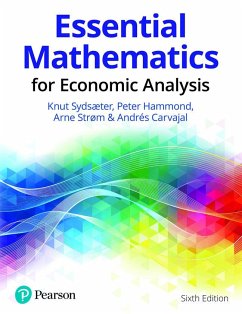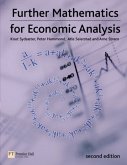- Broschiertes Buch
- Merkliste
- Auf die Merkliste
- Bewerten Bewerten
- Teilen
- Produkt teilen
- Produkterinnerung
- Produkterinnerung
Acquire the key mathematical skills you need to master and succeed in economics Essential Mathematics for Economic Analysis, 6th edition by Sydsaeter, Hammond, Strom and Carvajal is a global best-selling text that provides an extensive introduction to all the mathematical tools your students need to study economics at intermediate level. This book has been applauded for its scope and covers a broad range of mathematical knowledge, techniques and tools, progressing from elementary calculus to more advanced topics. With a wealth of practice examples, questions and solutions integrated…mehr
Andere Kunden interessierten sich auch für
![Further Mathematics for Economic Analysis Further Mathematics for Economic Analysis]() Knut SydsaeterFurther Mathematics for Economic Analysis123,99 €
Knut SydsaeterFurther Mathematics for Economic Analysis123,99 €![Essential Mathematics for Economics Essential Mathematics for Economics]() Alexis Akira TodaEssential Mathematics for Economics53,99 €
Alexis Akira TodaEssential Mathematics for Economics53,99 €![Essential Mathematics for Economics Essential Mathematics for Economics]() Alexis Akira TodaEssential Mathematics for Economics137,99 €
Alexis Akira TodaEssential Mathematics for Economics137,99 €![Applied Multivariate Statistical Analysis Applied Multivariate Statistical Analysis]() Richard JohnsonApplied Multivariate Statistical Analysis135,99 €
Richard JohnsonApplied Multivariate Statistical Analysis135,99 €![Financial Times Essential Guide to Business Writing, The Financial Times Essential Guide to Business Writing, The]() Ian AtkinsonFinancial Times Essential Guide to Business Writing, The24,99 €
Ian AtkinsonFinancial Times Essential Guide to Business Writing, The24,99 €![John E. Freund's Mathematical Statistics with Applications John E. Freund's Mathematical Statistics with Applications]() Irwin MillerJohn E. Freund's Mathematical Statistics with Applications108,99 €
Irwin MillerJohn E. Freund's Mathematical Statistics with Applications108,99 €![Digital Control System Analysis & Design, Global Edition Digital Control System Analysis & Design, Global Edition]() Charles PhillipsDigital Control System Analysis & Design, Global Edition122,99 €
Charles PhillipsDigital Control System Analysis & Design, Global Edition122,99 €-
-
-
Acquire the key mathematical skills you need to master and succeed in economics Essential Mathematics for Economic Analysis, 6th edition by Sydsaeter, Hammond, Strom and Carvajal is a global best-selling text that provides an extensive introduction to all the mathematical tools your students need to study economics at intermediate level. This book has been applauded for its scope and covers a broad range of mathematical knowledge, techniques and tools, progressing from elementary calculus to more advanced topics. With a wealth of practice examples, questions and solutions integrated throughout, as well as opportunities to apply them in specific economic situations, this book will help your students develop key mathematical skills as your course progresses. Key features: - Numerous exercises and worked examples throughout each chapter allow students to practise skills and improve techniques. - Review exercises at the end of each chapter test student understanding of a topic, allowing them to progress with confidence. - Solutions to exercises are provided in the book and online, showing students the steps needed to arrive at the correct answer. Reach every student by pairing this text with MyLab Economics GÇ£MyLabGäó is the teaching and learning platform that empowers you to reach every student. By combining trusted author content with digital tools and a flexible platform, MyLab personalizes the learning experience and improves results for each student. Pearson, the worldGÇÖs learning company.
Hinweis: Dieser Artikel kann nur an eine deutsche Lieferadresse ausgeliefert werden.
Hinweis: Dieser Artikel kann nur an eine deutsche Lieferadresse ausgeliefert werden.
Produktdetails
- Produktdetails
- Verlag: Pearson Education Limited
- 6 ed
- Seitenzahl: 976
- Erscheinungstermin: 15. April 2021
- Englisch
- Abmessung: 246mm x 189mm x 43mm
- Gewicht: 1576g
- ISBN-13: 9781292359281
- ISBN-10: 1292359285
- Artikelnr.: 61265565
- Herstellerkennzeichnung
- Libri GmbH
- Europaallee 1
- 36244 Bad Hersfeld
- gpsr@libri.de
- Verlag: Pearson Education Limited
- 6 ed
- Seitenzahl: 976
- Erscheinungstermin: 15. April 2021
- Englisch
- Abmessung: 246mm x 189mm x 43mm
- Gewicht: 1576g
- ISBN-13: 9781292359281
- ISBN-10: 1292359285
- Artikelnr.: 61265565
- Herstellerkennzeichnung
- Libri GmbH
- Europaallee 1
- 36244 Bad Hersfeld
- gpsr@libri.de
Knut Sydsaeter (1937-2012) was Emeritus Professor of Mathematics in the Economics Department at the University of Oslo, where he had taught mathematics to economists for over 45 years. Peter Hammond is currently a Professor of Economics at the University of Warwick, where he moved in 2007 after becoming an Emeritus Professor at Stanford University. He has taught Mathematics for Economists at both universities, as well as the universities of Oxford and Essex. Arne Strøm is Associate Professor Emeritus at the University of Oslo and has extensive experience in teaching mathematics to economists at the University Department of Economics. Andrés Carvajal is an Associate Professor in the Department of Economics at the University of California, Davis.
Preface
I PRELIMINARIES
1. Essentials of Logic and Set Theory
o Essentials of Set Theory
o Essentials of Logic
o Mathematical Proofs
o Mathematical Induction
Review Exercises
2. Algebra
o The Real Numbers
o Integer Powers
o Rules of Algebra
o Fractions
o Fractional Powers
o Inequalities
o Intervals and Absolute Values
o Sign Diagrams
o Summation Notation
o Rules for Sums
o Newton's Binomial Formula
o Double Sums
Review Exercises
3. Solving Equations
o Solving Equations
o Equations and Their Parameters
o Quadratic Equations
o Some Nonlinear Equations
o Using Implication Arrows
o Two Linear Equations in Two Unknowns
Review Exercises
4. Functions of One Variable
o Introduction
o Definitions
o Graphs of Functions
o Linear Functions
o Linear Models
o Quadratic Functions
o Polynomials
o Power Functions
o Exponential Functions
o Logarithmic Functions
Review Exercises
5. Properties of Functions
o Shifting Graphs
o New Functions From Old
o Inverse Functions
o Graphs of Equations
o Distance in The Plane
o General Functions
Review Exercises
II SINGLE-VARIABLE CALCULUS
1. Differentiation
* Slopes of Curves
* Tangents and Derivatives
* Increasing and Decreasing Functions
* Economic Applications
* A Brief Introduction to Limits
* Simple Rules for Differentiation
* Sums, Products, and Quotients
* The Chain Rule
* Higher-Order Derivatives
* Exponential Functions
* Logarithmic Functions
Review Exercises
2. Derivatives in Use
* Implicit Differentiation
* Economic Examples
* The Inverse Function Theorem
* Linear Approximations
* Polynomial Approximations
* Taylor's Formula
* Elasticities
* Continuity
* More on Limits
* The Intermediate Value Theorem
* Infinite Sequences
* L'Hôpital's Rule Review Exercises
Review Exercises
3. Concave and Convex Functions
* Intuition
* Definitions
* General Properties
* First Derivative Tests
* Second Derivative Tests
* Inflection Points
Review Exercises
4. Optimization
* Extreme Points
* Simple Tests for Extreme Points
* Economic Examples
* The Extreme and Mean Value Theorems
* Further Economic Examples
* Local Extreme Points
Review Exercises
5. Integration
* Indefinite Integrals
* Area and Definite Integrals
* Properties of Definite Integrals
* Economic Applications
* Integration by Parts
* Integration by Substitution
* Infinite Intervals of Integration
Review Exercises
6. Topics in Finance and Dynamics
* Interest Periods and Effective Rates
* Continuous Compounding
* Present Value
* Geometric Series
* Total Present Value
* Mortgage Repayments
* Internal Rate of Return
* A Glimpse at Difference Equations
* Essentials of Differential Equations
* Separable and Linear Differential Equations
Review Exercises III MULTI-VARIABLE ALGEBRA
7. Matrix Algebra
* Matrices and Vectors
* Systems of Linear Equations
* Matrix Addition
* Algebra of Vectors
* Matrix Multiplication
* Rules for Matrix Multiplication
* The Transpose
* Gaussian Elimination
* Geometric Interpretation of Vectors
* Lines and Planes
Review Exercises
8. Determinants, Inverses, and Quadratic Forms
* Determinants of Order 2
* Determinants of Order 3
* Determinants in General
* Basic Rules for Determinants
* Expansion by Cofactors
* The Inverse of a Matrix
* A General Formula for The Inverse
* Cramer's Rule
* The Leontief Mode
* Eigenvalues and Eigenvectors
* Diagonalization
* Quadratic Forms
Review Exercises
IV MULTI-VARIABLE CALCULUS
9. Multivariable Functions
* Functions of Two Variables
* Partial Derivatives with Two Variables
* Geometric Representation
* Surfaces and Distance
* Functions of More Variables
* Partial Derivatives with More Variables
* Convex Sets
* Concave and Convex Functions
* Economic Applications
* Partial Elasticities
Review Exercises
10. Partial Derivatives in Use
* A Simple Chain Rule
* Chain Rules for Many Variables
* Implicit Differentiation Along A Level Curve
* Level Surfaces
* Elasticity of Substitution
* Homogeneous Functions of Two Variables
* Homogeneous and Homothetic Functions
* Linear Approximations
* Differentials
* Systems of Equations
* Differentiating Systems of Equations
Review Exercises
11. Multiple Integrals
* Double Integrals Over Finite Rectangles
* Infinite Rectangles of Integration
* Discontinuous Integrands and Other Extensions
* Integration Over Many Variables
Review Exercises
V MULTI-VARIABLE OPTIMIZATION
12. Unconstrained Optimization
* Two Choice Variables: Necessary Conditions
* Two Choice Variables: Sufficient Conditions
* Local Extreme Points
* Linear Models with Quadratic Objectives
* The Extreme Value Theorem
* Functions of More Variables
* Comparative Statics and the Envelope Theorem
Review Exercises
13. Equality Constraints
* The Lagrange Multiplier Method
* Interpreting the Lagrange Multiplier
* Multiple Solution Candidates
* Why Does the Lagrange Multiplier Method Work?
* Sufficient Conditions
* Additional Variables and Constraints
* Comparative Statics
Review Exercises
14. Linear Programming
* A Graphical Approach
* Introduction to Duality Theory
* The Duality Theorem
* A General Economic Interpretation
* Complementary Slackness
Review Exercises
15. Nonlinear Programming
* Two Variables and One Constraint
* Many Variables and Inequality Constraints
* Nonnegativity Constraints
Review Exercises Appendix
16. Geometry
17. The Greek Alphabet
18. Bibliography
Solutions to the Exercises Index Publisher's Acknowledgments
I PRELIMINARIES
1. Essentials of Logic and Set Theory
o Essentials of Set Theory
o Essentials of Logic
o Mathematical Proofs
o Mathematical Induction
Review Exercises
2. Algebra
o The Real Numbers
o Integer Powers
o Rules of Algebra
o Fractions
o Fractional Powers
o Inequalities
o Intervals and Absolute Values
o Sign Diagrams
o Summation Notation
o Rules for Sums
o Newton's Binomial Formula
o Double Sums
Review Exercises
3. Solving Equations
o Solving Equations
o Equations and Their Parameters
o Quadratic Equations
o Some Nonlinear Equations
o Using Implication Arrows
o Two Linear Equations in Two Unknowns
Review Exercises
4. Functions of One Variable
o Introduction
o Definitions
o Graphs of Functions
o Linear Functions
o Linear Models
o Quadratic Functions
o Polynomials
o Power Functions
o Exponential Functions
o Logarithmic Functions
Review Exercises
5. Properties of Functions
o Shifting Graphs
o New Functions From Old
o Inverse Functions
o Graphs of Equations
o Distance in The Plane
o General Functions
Review Exercises
II SINGLE-VARIABLE CALCULUS
1. Differentiation
* Slopes of Curves
* Tangents and Derivatives
* Increasing and Decreasing Functions
* Economic Applications
* A Brief Introduction to Limits
* Simple Rules for Differentiation
* Sums, Products, and Quotients
* The Chain Rule
* Higher-Order Derivatives
* Exponential Functions
* Logarithmic Functions
Review Exercises
2. Derivatives in Use
* Implicit Differentiation
* Economic Examples
* The Inverse Function Theorem
* Linear Approximations
* Polynomial Approximations
* Taylor's Formula
* Elasticities
* Continuity
* More on Limits
* The Intermediate Value Theorem
* Infinite Sequences
* L'Hôpital's Rule Review Exercises
Review Exercises
3. Concave and Convex Functions
* Intuition
* Definitions
* General Properties
* First Derivative Tests
* Second Derivative Tests
* Inflection Points
Review Exercises
4. Optimization
* Extreme Points
* Simple Tests for Extreme Points
* Economic Examples
* The Extreme and Mean Value Theorems
* Further Economic Examples
* Local Extreme Points
Review Exercises
5. Integration
* Indefinite Integrals
* Area and Definite Integrals
* Properties of Definite Integrals
* Economic Applications
* Integration by Parts
* Integration by Substitution
* Infinite Intervals of Integration
Review Exercises
6. Topics in Finance and Dynamics
* Interest Periods and Effective Rates
* Continuous Compounding
* Present Value
* Geometric Series
* Total Present Value
* Mortgage Repayments
* Internal Rate of Return
* A Glimpse at Difference Equations
* Essentials of Differential Equations
* Separable and Linear Differential Equations
Review Exercises III MULTI-VARIABLE ALGEBRA
7. Matrix Algebra
* Matrices and Vectors
* Systems of Linear Equations
* Matrix Addition
* Algebra of Vectors
* Matrix Multiplication
* Rules for Matrix Multiplication
* The Transpose
* Gaussian Elimination
* Geometric Interpretation of Vectors
* Lines and Planes
Review Exercises
8. Determinants, Inverses, and Quadratic Forms
* Determinants of Order 2
* Determinants of Order 3
* Determinants in General
* Basic Rules for Determinants
* Expansion by Cofactors
* The Inverse of a Matrix
* A General Formula for The Inverse
* Cramer's Rule
* The Leontief Mode
* Eigenvalues and Eigenvectors
* Diagonalization
* Quadratic Forms
Review Exercises
IV MULTI-VARIABLE CALCULUS
9. Multivariable Functions
* Functions of Two Variables
* Partial Derivatives with Two Variables
* Geometric Representation
* Surfaces and Distance
* Functions of More Variables
* Partial Derivatives with More Variables
* Convex Sets
* Concave and Convex Functions
* Economic Applications
* Partial Elasticities
Review Exercises
10. Partial Derivatives in Use
* A Simple Chain Rule
* Chain Rules for Many Variables
* Implicit Differentiation Along A Level Curve
* Level Surfaces
* Elasticity of Substitution
* Homogeneous Functions of Two Variables
* Homogeneous and Homothetic Functions
* Linear Approximations
* Differentials
* Systems of Equations
* Differentiating Systems of Equations
Review Exercises
11. Multiple Integrals
* Double Integrals Over Finite Rectangles
* Infinite Rectangles of Integration
* Discontinuous Integrands and Other Extensions
* Integration Over Many Variables
Review Exercises
V MULTI-VARIABLE OPTIMIZATION
12. Unconstrained Optimization
* Two Choice Variables: Necessary Conditions
* Two Choice Variables: Sufficient Conditions
* Local Extreme Points
* Linear Models with Quadratic Objectives
* The Extreme Value Theorem
* Functions of More Variables
* Comparative Statics and the Envelope Theorem
Review Exercises
13. Equality Constraints
* The Lagrange Multiplier Method
* Interpreting the Lagrange Multiplier
* Multiple Solution Candidates
* Why Does the Lagrange Multiplier Method Work?
* Sufficient Conditions
* Additional Variables and Constraints
* Comparative Statics
Review Exercises
14. Linear Programming
* A Graphical Approach
* Introduction to Duality Theory
* The Duality Theorem
* A General Economic Interpretation
* Complementary Slackness
Review Exercises
15. Nonlinear Programming
* Two Variables and One Constraint
* Many Variables and Inequality Constraints
* Nonnegativity Constraints
Review Exercises Appendix
16. Geometry
17. The Greek Alphabet
18. Bibliography
Solutions to the Exercises Index Publisher's Acknowledgments
Preface
I PRELIMINARIES
1. Essentials of Logic and Set Theory
o Essentials of Set Theory
o Essentials of Logic
o Mathematical Proofs
o Mathematical Induction
Review Exercises
2. Algebra
o The Real Numbers
o Integer Powers
o Rules of Algebra
o Fractions
o Fractional Powers
o Inequalities
o Intervals and Absolute Values
o Sign Diagrams
o Summation Notation
o Rules for Sums
o Newton's Binomial Formula
o Double Sums
Review Exercises
3. Solving Equations
o Solving Equations
o Equations and Their Parameters
o Quadratic Equations
o Some Nonlinear Equations
o Using Implication Arrows
o Two Linear Equations in Two Unknowns
Review Exercises
4. Functions of One Variable
o Introduction
o Definitions
o Graphs of Functions
o Linear Functions
o Linear Models
o Quadratic Functions
o Polynomials
o Power Functions
o Exponential Functions
o Logarithmic Functions
Review Exercises
5. Properties of Functions
o Shifting Graphs
o New Functions From Old
o Inverse Functions
o Graphs of Equations
o Distance in The Plane
o General Functions
Review Exercises
II SINGLE-VARIABLE CALCULUS
1. Differentiation
* Slopes of Curves
* Tangents and Derivatives
* Increasing and Decreasing Functions
* Economic Applications
* A Brief Introduction to Limits
* Simple Rules for Differentiation
* Sums, Products, and Quotients
* The Chain Rule
* Higher-Order Derivatives
* Exponential Functions
* Logarithmic Functions
Review Exercises
2. Derivatives in Use
* Implicit Differentiation
* Economic Examples
* The Inverse Function Theorem
* Linear Approximations
* Polynomial Approximations
* Taylor's Formula
* Elasticities
* Continuity
* More on Limits
* The Intermediate Value Theorem
* Infinite Sequences
* L'Hôpital's Rule Review Exercises
Review Exercises
3. Concave and Convex Functions
* Intuition
* Definitions
* General Properties
* First Derivative Tests
* Second Derivative Tests
* Inflection Points
Review Exercises
4. Optimization
* Extreme Points
* Simple Tests for Extreme Points
* Economic Examples
* The Extreme and Mean Value Theorems
* Further Economic Examples
* Local Extreme Points
Review Exercises
5. Integration
* Indefinite Integrals
* Area and Definite Integrals
* Properties of Definite Integrals
* Economic Applications
* Integration by Parts
* Integration by Substitution
* Infinite Intervals of Integration
Review Exercises
6. Topics in Finance and Dynamics
* Interest Periods and Effective Rates
* Continuous Compounding
* Present Value
* Geometric Series
* Total Present Value
* Mortgage Repayments
* Internal Rate of Return
* A Glimpse at Difference Equations
* Essentials of Differential Equations
* Separable and Linear Differential Equations
Review Exercises III MULTI-VARIABLE ALGEBRA
7. Matrix Algebra
* Matrices and Vectors
* Systems of Linear Equations
* Matrix Addition
* Algebra of Vectors
* Matrix Multiplication
* Rules for Matrix Multiplication
* The Transpose
* Gaussian Elimination
* Geometric Interpretation of Vectors
* Lines and Planes
Review Exercises
8. Determinants, Inverses, and Quadratic Forms
* Determinants of Order 2
* Determinants of Order 3
* Determinants in General
* Basic Rules for Determinants
* Expansion by Cofactors
* The Inverse of a Matrix
* A General Formula for The Inverse
* Cramer's Rule
* The Leontief Mode
* Eigenvalues and Eigenvectors
* Diagonalization
* Quadratic Forms
Review Exercises
IV MULTI-VARIABLE CALCULUS
9. Multivariable Functions
* Functions of Two Variables
* Partial Derivatives with Two Variables
* Geometric Representation
* Surfaces and Distance
* Functions of More Variables
* Partial Derivatives with More Variables
* Convex Sets
* Concave and Convex Functions
* Economic Applications
* Partial Elasticities
Review Exercises
10. Partial Derivatives in Use
* A Simple Chain Rule
* Chain Rules for Many Variables
* Implicit Differentiation Along A Level Curve
* Level Surfaces
* Elasticity of Substitution
* Homogeneous Functions of Two Variables
* Homogeneous and Homothetic Functions
* Linear Approximations
* Differentials
* Systems of Equations
* Differentiating Systems of Equations
Review Exercises
11. Multiple Integrals
* Double Integrals Over Finite Rectangles
* Infinite Rectangles of Integration
* Discontinuous Integrands and Other Extensions
* Integration Over Many Variables
Review Exercises
V MULTI-VARIABLE OPTIMIZATION
12. Unconstrained Optimization
* Two Choice Variables: Necessary Conditions
* Two Choice Variables: Sufficient Conditions
* Local Extreme Points
* Linear Models with Quadratic Objectives
* The Extreme Value Theorem
* Functions of More Variables
* Comparative Statics and the Envelope Theorem
Review Exercises
13. Equality Constraints
* The Lagrange Multiplier Method
* Interpreting the Lagrange Multiplier
* Multiple Solution Candidates
* Why Does the Lagrange Multiplier Method Work?
* Sufficient Conditions
* Additional Variables and Constraints
* Comparative Statics
Review Exercises
14. Linear Programming
* A Graphical Approach
* Introduction to Duality Theory
* The Duality Theorem
* A General Economic Interpretation
* Complementary Slackness
Review Exercises
15. Nonlinear Programming
* Two Variables and One Constraint
* Many Variables and Inequality Constraints
* Nonnegativity Constraints
Review Exercises Appendix
16. Geometry
17. The Greek Alphabet
18. Bibliography
Solutions to the Exercises Index Publisher's Acknowledgments
I PRELIMINARIES
1. Essentials of Logic and Set Theory
o Essentials of Set Theory
o Essentials of Logic
o Mathematical Proofs
o Mathematical Induction
Review Exercises
2. Algebra
o The Real Numbers
o Integer Powers
o Rules of Algebra
o Fractions
o Fractional Powers
o Inequalities
o Intervals and Absolute Values
o Sign Diagrams
o Summation Notation
o Rules for Sums
o Newton's Binomial Formula
o Double Sums
Review Exercises
3. Solving Equations
o Solving Equations
o Equations and Their Parameters
o Quadratic Equations
o Some Nonlinear Equations
o Using Implication Arrows
o Two Linear Equations in Two Unknowns
Review Exercises
4. Functions of One Variable
o Introduction
o Definitions
o Graphs of Functions
o Linear Functions
o Linear Models
o Quadratic Functions
o Polynomials
o Power Functions
o Exponential Functions
o Logarithmic Functions
Review Exercises
5. Properties of Functions
o Shifting Graphs
o New Functions From Old
o Inverse Functions
o Graphs of Equations
o Distance in The Plane
o General Functions
Review Exercises
II SINGLE-VARIABLE CALCULUS
1. Differentiation
* Slopes of Curves
* Tangents and Derivatives
* Increasing and Decreasing Functions
* Economic Applications
* A Brief Introduction to Limits
* Simple Rules for Differentiation
* Sums, Products, and Quotients
* The Chain Rule
* Higher-Order Derivatives
* Exponential Functions
* Logarithmic Functions
Review Exercises
2. Derivatives in Use
* Implicit Differentiation
* Economic Examples
* The Inverse Function Theorem
* Linear Approximations
* Polynomial Approximations
* Taylor's Formula
* Elasticities
* Continuity
* More on Limits
* The Intermediate Value Theorem
* Infinite Sequences
* L'Hôpital's Rule Review Exercises
Review Exercises
3. Concave and Convex Functions
* Intuition
* Definitions
* General Properties
* First Derivative Tests
* Second Derivative Tests
* Inflection Points
Review Exercises
4. Optimization
* Extreme Points
* Simple Tests for Extreme Points
* Economic Examples
* The Extreme and Mean Value Theorems
* Further Economic Examples
* Local Extreme Points
Review Exercises
5. Integration
* Indefinite Integrals
* Area and Definite Integrals
* Properties of Definite Integrals
* Economic Applications
* Integration by Parts
* Integration by Substitution
* Infinite Intervals of Integration
Review Exercises
6. Topics in Finance and Dynamics
* Interest Periods and Effective Rates
* Continuous Compounding
* Present Value
* Geometric Series
* Total Present Value
* Mortgage Repayments
* Internal Rate of Return
* A Glimpse at Difference Equations
* Essentials of Differential Equations
* Separable and Linear Differential Equations
Review Exercises III MULTI-VARIABLE ALGEBRA
7. Matrix Algebra
* Matrices and Vectors
* Systems of Linear Equations
* Matrix Addition
* Algebra of Vectors
* Matrix Multiplication
* Rules for Matrix Multiplication
* The Transpose
* Gaussian Elimination
* Geometric Interpretation of Vectors
* Lines and Planes
Review Exercises
8. Determinants, Inverses, and Quadratic Forms
* Determinants of Order 2
* Determinants of Order 3
* Determinants in General
* Basic Rules for Determinants
* Expansion by Cofactors
* The Inverse of a Matrix
* A General Formula for The Inverse
* Cramer's Rule
* The Leontief Mode
* Eigenvalues and Eigenvectors
* Diagonalization
* Quadratic Forms
Review Exercises
IV MULTI-VARIABLE CALCULUS
9. Multivariable Functions
* Functions of Two Variables
* Partial Derivatives with Two Variables
* Geometric Representation
* Surfaces and Distance
* Functions of More Variables
* Partial Derivatives with More Variables
* Convex Sets
* Concave and Convex Functions
* Economic Applications
* Partial Elasticities
Review Exercises
10. Partial Derivatives in Use
* A Simple Chain Rule
* Chain Rules for Many Variables
* Implicit Differentiation Along A Level Curve
* Level Surfaces
* Elasticity of Substitution
* Homogeneous Functions of Two Variables
* Homogeneous and Homothetic Functions
* Linear Approximations
* Differentials
* Systems of Equations
* Differentiating Systems of Equations
Review Exercises
11. Multiple Integrals
* Double Integrals Over Finite Rectangles
* Infinite Rectangles of Integration
* Discontinuous Integrands and Other Extensions
* Integration Over Many Variables
Review Exercises
V MULTI-VARIABLE OPTIMIZATION
12. Unconstrained Optimization
* Two Choice Variables: Necessary Conditions
* Two Choice Variables: Sufficient Conditions
* Local Extreme Points
* Linear Models with Quadratic Objectives
* The Extreme Value Theorem
* Functions of More Variables
* Comparative Statics and the Envelope Theorem
Review Exercises
13. Equality Constraints
* The Lagrange Multiplier Method
* Interpreting the Lagrange Multiplier
* Multiple Solution Candidates
* Why Does the Lagrange Multiplier Method Work?
* Sufficient Conditions
* Additional Variables and Constraints
* Comparative Statics
Review Exercises
14. Linear Programming
* A Graphical Approach
* Introduction to Duality Theory
* The Duality Theorem
* A General Economic Interpretation
* Complementary Slackness
Review Exercises
15. Nonlinear Programming
* Two Variables and One Constraint
* Many Variables and Inequality Constraints
* Nonnegativity Constraints
Review Exercises Appendix
16. Geometry
17. The Greek Alphabet
18. Bibliography
Solutions to the Exercises Index Publisher's Acknowledgments








